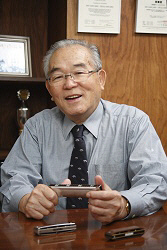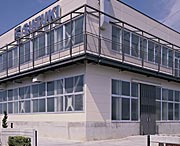- U bent hier: Home
- Hammond
- Hammond Suzuki
- Mr. Manji Suzuki Eng
Mr. Manji Suzuki
SUZUKI is one of todays leading Japanese manufacturers and has gained international respect among partners and customers alike for its humanity, loyalty, quality and innovation.
But what about the man behind the company?
Mr. Manji Suzuki was born in 1923 and remains one of the most important and influential people in the Musical Instrument Industry. He has maintained a solid belief in the importance of making music available to as many people as possible. Over the years he has pioneered many incredible and innovative instruments that we are privileged to enjoy today.
Mr. Suzuki passed away in 2020.
Humble Beginnings
Far from the bustle and prestige of his Hamamatsu office, the past saw a young Manji Suzuki hand building harmonicas himself in a rented room on a farm estate located in Sumiyoshi town Japan. Electricity was only available to him at night though as the farmer used the generator to draw water to his rice paddy during the day. Because of this Mr. Suzuki often worked until 1 or 2 o'clock in the morning making his beloved harmonicas!
A friend joined Mr. Suzuki to make the work easier and after a year they borrowed money and the small operation was moved to the first floor of a property in Ryuzenji town. This was a new and exciting start with working space of some 27m2, plus a few tools and machines.
Having gained the ability to manufacture harmonicas in larger numbers, it soon became apparent they needed to learn how to sell them! Acquaintances introduced them to wholesalers in Tokyo and Osaka. The business developed due to Mr. Suzuki's hard work and persistence.
By Appointment
In the following years Harmonicas, due to their ease of play, size and cost were used more and more for teaching music. This greatly expanded sales for Mr. Suzuki. However 1947 saw a significant step forward for Music and the Arts in Japan. The Ministry of Education in its "Guidelines for Teaching" stipulated the need to introduce certain instruments into education. These would include various rhythm instruments such as Castanets, Xylophones, Recorders as well as Harmonicas, all of which would be easy to use and play. As a result of this Government intervention, Harmonicas were high-lighted as a serious and useful instrument. The government guidelines were revised in 1951 and again in 1958 at which time they clearly stated the need to utilize harmonicas in all stages of compulsory education from the 1st grade of Primary school to the 3rd grade of Junior High School. By this time, harmonica demand rapidly increased!
Suzuki Musical Inst. Mfg. Co., Ltd. was established in 1952 and 1954 saw the start of the company's full scale production at the present location in Ryoke in Hamamatsu. The company grew, as the demand for harmonicas continued. By 1957/58 Hamamatsu was the booming capital of harmonica production with more than 21 harmonica manufacturers. Suzuki produced as many as 700,000 pieces annually at the peak.
According to MITI’s data at the time, the total Japanese domestic harmonica output was:
1952: 1,500,000 pieces
1958: 3,090,000 pieces
1963: 7,020,000 pieces
Hieronder het hoofdkantoor in Hamamatsu Japan/ Main Suzuki office in Hamamatsu Japan
Due to the Educational Ministry's suggestion to offer low cost Harmonicas to primary schools very large amounts of harmonicas were required but with so many manufacturers trying to sell their harmonicas many could not cope with competition. Today the only harmonica manufacturer doing business in Hamamatsu on a world wide scale is Suzuki.
Keyboard Harmonica
Another milestone in the development of Suzuki Musical Instruments was the introduction of the Suzuki Melodeon, which became a key product for school.
Mr. Suzuki first saw a Hohner ‘Melodica' in a department store in Osaka, around 1959. The instrument fascinated him and so he bought it. It was a button-type model (German) and although unusable in education Mr. Suzuki saw potential for something similar. As the basis in teaching music is the Piano Keyboard, he decided to build a new version and by 1961 the Melodeon was born with keys instead of buttons. It happened to catch the eye of an officer of the Ministry of education who insisted they introduce the product to schools.
Initially there was some resistance and the press criticized it as being too expensive as a school instrument. Despite this it gradually became accepted, especially with the introduction of the flexible extended 'hose' mouth piece, allowing the Melodeon to be placed on a desk top and played like a traditional keyboard! This idea was welcomed by teachers as being highly effective for teaching both breath control and keyboard skills at the same time!
By 1967 this ‘Keyboard Harmonica' was included as standard equipment in schools and by 1968 the Educational Ministry’s examiners announced that this 'Keyboard Harmonica' will be a good replacement for a standard Harmonica, Organ or Keyboard.”
This accelerated the demand making the Melodeon the backbone of the company, with Suzuki taking 60% of the share of the market at the peak.
By Design
As a born engineer Mr. Suzuki was naturally gifted, which came in useful when designing and building the machinery and tools needed to create precision products.
The machinery that can be seen in the factories today, such as Dies and Molds, Precision Processing Machines for reeds, Automatic Welding Machines, Automated Tuning Machines, etc were mostly made and designed within their own plants. There are obvious advantages and more control having everything contained within the Suzuki group of companies.
Hieronder één van de de Suzuki-fabrieken/ One of the Suzuki production plant
Philosophy
Mr. Suzuki's realized the importance of respecting customers opinions as much as possible and to incorporate those ideas into the products manufactured. For this reason he would dedicate half of each month visiting schools to meet teachers and listen carefully to their opinions, desires and requests. He quite literally journeyed from one end of Japan to the other, even including the Miyakojima Islands. Due to this close, personal contact many of the principals and teachers became friends and would call him by his first name or even his nickname ‘Man-Chan’. Many seminars were held and teachers would learn to instruct their pupils and were happy to promote the Suzuki products. They also shared any of their good ideas and the product line gradually expanded. Mr. Suzuki's close working relationship truly benefited everyone involved.
Mr. Suzuki believes in the value of teaching and introducing musical instruments to people of all ages. Ensemble playing was very important in the past, so it should be in the future, as children learn to play together, work together and in the same way develop life long friendships.
The decision was made to market Suzuki products direct, rather than working through wholesalers. This made sense, particularly as their main markets were schools.
Taishoh-koto
Continuing his philosophy of music for everyone, Mr. Suzuki chose another instrument to help people capture their gift of Music: the Taishoh-koto which is based on a traditional Japanese instrument, the Koto.
Mr. Suzuki started experimental teaching classes as early as 1957 and the learning curve is still continuing! The idea was to offer a philosophy and way of teaching, not just the instruments themselves, which would be an important factor in developing and maintaining healthy markets.
Suzuki started the Taishoh-koto classes, using the local/district meeting halls situated near their sales offices. Now this is the largest scale organization in this category. There are quite a few families of the Taishoh-koto methods all over Japan. The Taishoh-koto has established its position as a main centre for the middle age to senior citizens in so called ‘Life-long Study’.
In 1992 the Taishoh-koto Association was organized as a corporation, proof of how popular the activities were becoming.
In 1994, Suzuki Harmonica Promotion Association was organized for promoting group lesson classes for ensemble-focused instruction. The country's top musicians chaired this organization. The first was Mr. Naozumi Yamamoto, a world-famous composer. The second was Mr. Hiroshi Miyagawa, a Japan's leading composer. (Both of them now passed away)
The current chairman is Mr. Kei Ogura, also a popular composer.
Today's Suzuki MI Group consists of the following companies:
Suzuki Musical Inst. Mfg. Co., Ltd.
Manufacturing headquarters with R&D, metal works plant, parts processing & assembly depts.
Universe Precision Works Co., Ltd. (est. 1971)
Various plastic parts are molded, injected and assembled here.
Tsumori Precision Machinery Co., Ltd (est. 1973)
Design and assembles precision molds and various automation machines.
Suzuki Educational Software Co., Ltd. (est. 1984)
R&D of educational software and promotion of the PC usage for schools.
Suzuki Musical Promotion Co., Ltd. (est. 1985)
For organizing and promoting music classes for adults, and holding concerts and seminars.
Hammond Suzuki Co., Ltd. (est. 1986)
For marketing and sales of Hammond Organs and Leslie Speakers.
Suzuki Musical Inst. Sales Co., Ltd. (est. 1971)
Covering the domestic market territory of Japan.
Suzuki Corporation (est. 1974)
Responsible for overseas sales
Overseas subsidiaries:
Hammond Suzuki USA, Inc. Addison Illinois
Hammond Suzuki Europe B.V. (Vianen Holland)
Suzuki Europe Ltd (UK)
Nanjing Suzuki Music & School Inst. Mfg. Co., Ltd., China
Suzuki Musical Inst. Trading (Shanghai) Co., Ltd.


